Case Study: Analyzing M&S's Competitive Strategy and Stakeholders
VerifiedAdded on 2023/06/11
|7
|1051
|359
Case Study
AI Summary
This case study provides an in-depth analysis of Marks & Spencer (M&S), a UK-based international retailer. It examines the company's competitive strategy using the VRIN framework to assess its resources and capabilities, including brand reputation, product quality, innovation, store location, and distribution channels. The analysis identifies sustained competitive advantages in brand recognition, innovative products, and product quality, while store location and distribution channels offer temporary advantages. The study also explores M&S's cost leadership strategy and its impact on competitive forces, procurement costs, and market development. Finally, the case study classifies M&S's stakeholders—including shareholders, government, consumers, employees, and investors—based on their power and interest levels, providing a stakeholder map for effective engagement and satisfaction. Desklib is your go-to platform for accessing similar solved assignments and study resources.
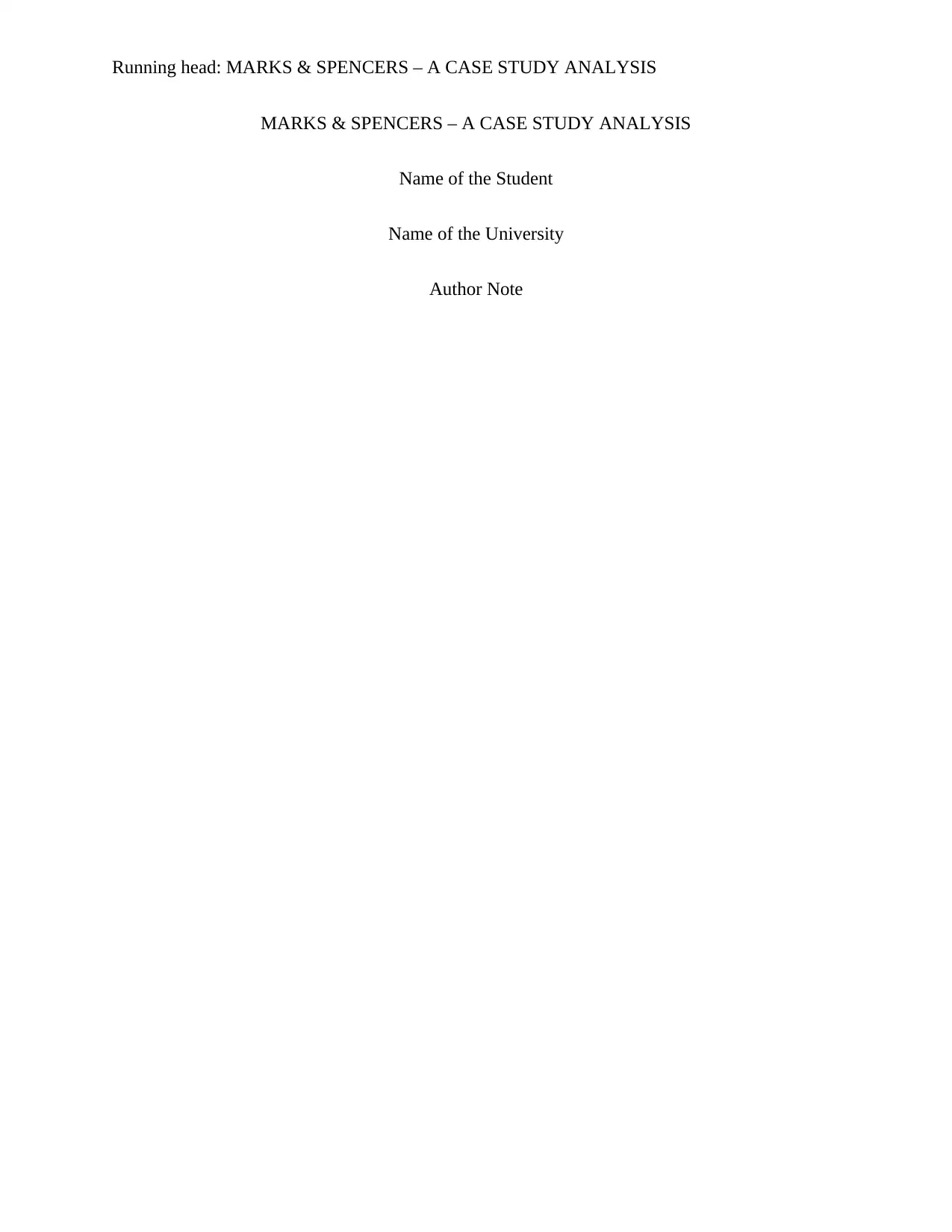
Running head: MARKS & SPENCERS – A CASE STUDY ANALYSIS
MARKS & SPENCERS – A CASE STUDY ANALYSIS
Name of the Student
Name of the University
Author Note
MARKS & SPENCERS – A CASE STUDY ANALYSIS
Name of the Student
Name of the University
Author Note
Paraphrase This Document
Need a fresh take? Get an instant paraphrase of this document with our AI Paraphraser
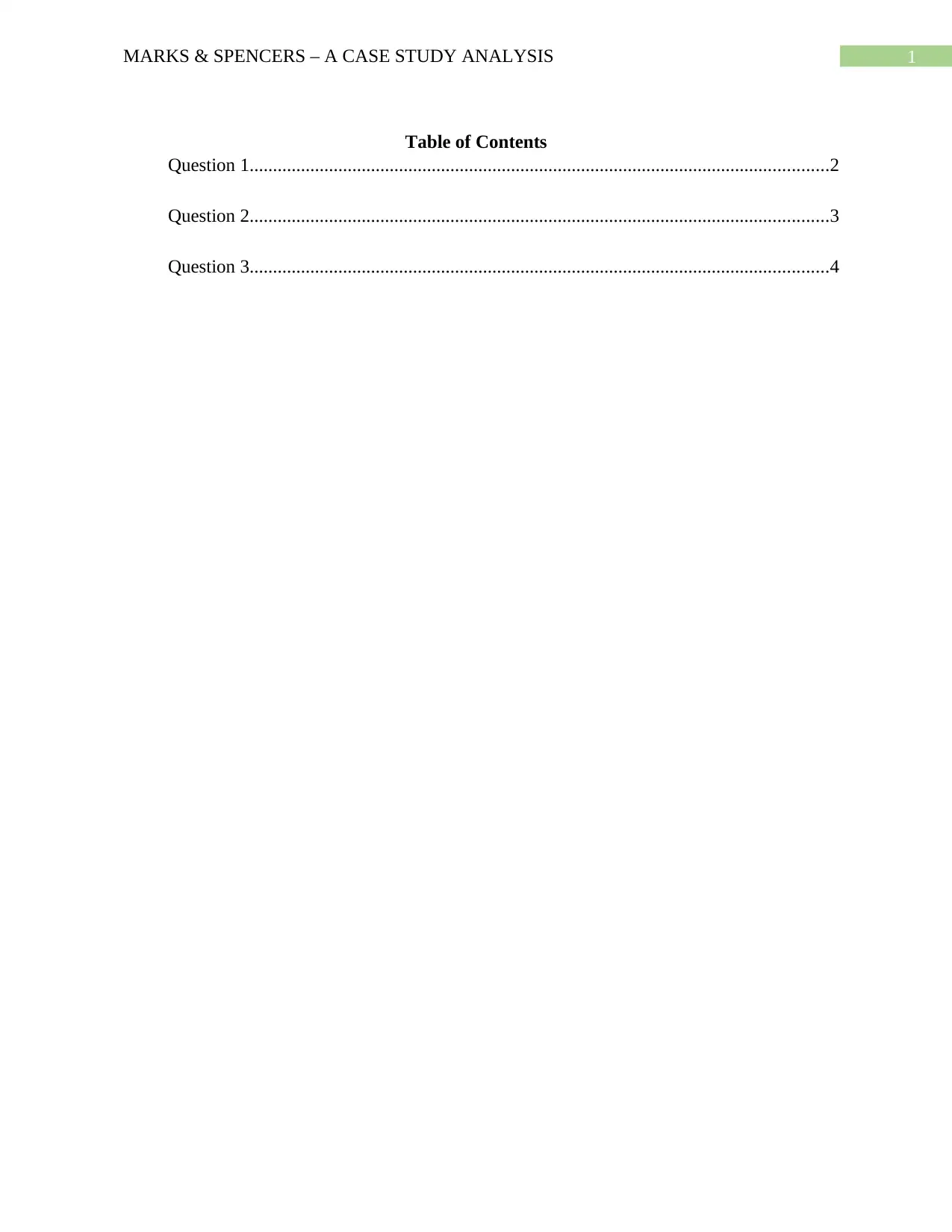
1MARKS & SPENCERS – A CASE STUDY ANALYSIS
Table of Contents
Question 1............................................................................................................................2
Question 2............................................................................................................................3
Question 3............................................................................................................................4
Table of Contents
Question 1............................................................................................................................2
Question 2............................................................................................................................3
Question 3............................................................................................................................4
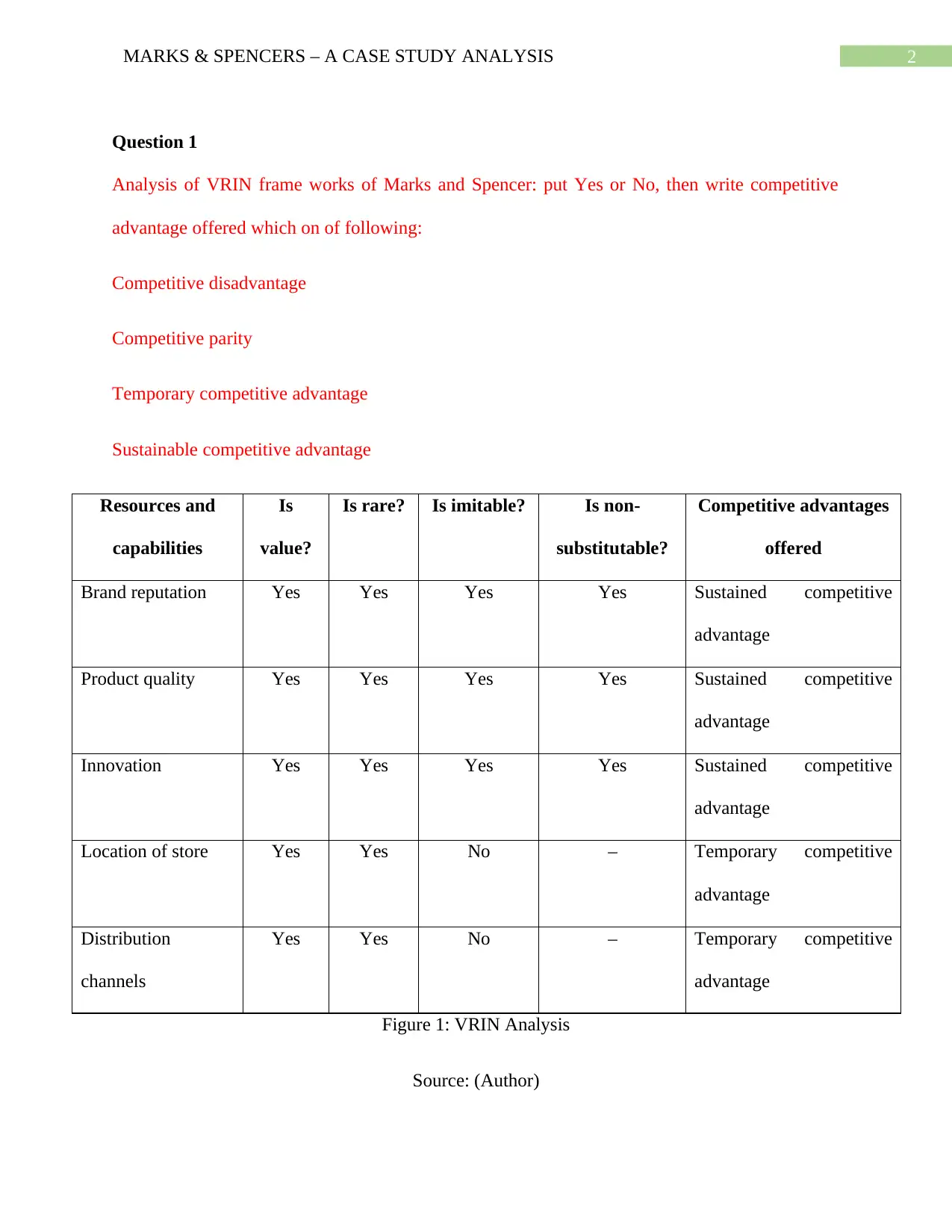
2MARKS & SPENCERS – A CASE STUDY ANALYSIS
Question 1
Analysis of VRIN frame works of Marks and Spencer: put Yes or No, then write competitive
advantage offered which on of following:
Competitive disadvantage
Competitive parity
Temporary competitive advantage
Sustainable competitive advantage
Resources and
capabilities
Is
value?
Is rare? Is imitable? Is non-
substitutable?
Competitive advantages
offered
Brand reputation Yes Yes Yes Yes Sustained competitive
advantage
Product quality Yes Yes Yes Yes Sustained competitive
advantage
Innovation Yes Yes Yes Yes Sustained competitive
advantage
Location of store Yes Yes No – Temporary competitive
advantage
Distribution
channels
Yes Yes No – Temporary competitive
advantage
Figure 1: VRIN Analysis
Source: (Author)
Question 1
Analysis of VRIN frame works of Marks and Spencer: put Yes or No, then write competitive
advantage offered which on of following:
Competitive disadvantage
Competitive parity
Temporary competitive advantage
Sustainable competitive advantage
Resources and
capabilities
Is
value?
Is rare? Is imitable? Is non-
substitutable?
Competitive advantages
offered
Brand reputation Yes Yes Yes Yes Sustained competitive
advantage
Product quality Yes Yes Yes Yes Sustained competitive
advantage
Innovation Yes Yes Yes Yes Sustained competitive
advantage
Location of store Yes Yes No – Temporary competitive
advantage
Distribution
channels
Yes Yes No – Temporary competitive
advantage
Figure 1: VRIN Analysis
Source: (Author)
⊘ This is a preview!⊘
Do you want full access?
Subscribe today to unlock all pages.

Trusted by 1+ million students worldwide
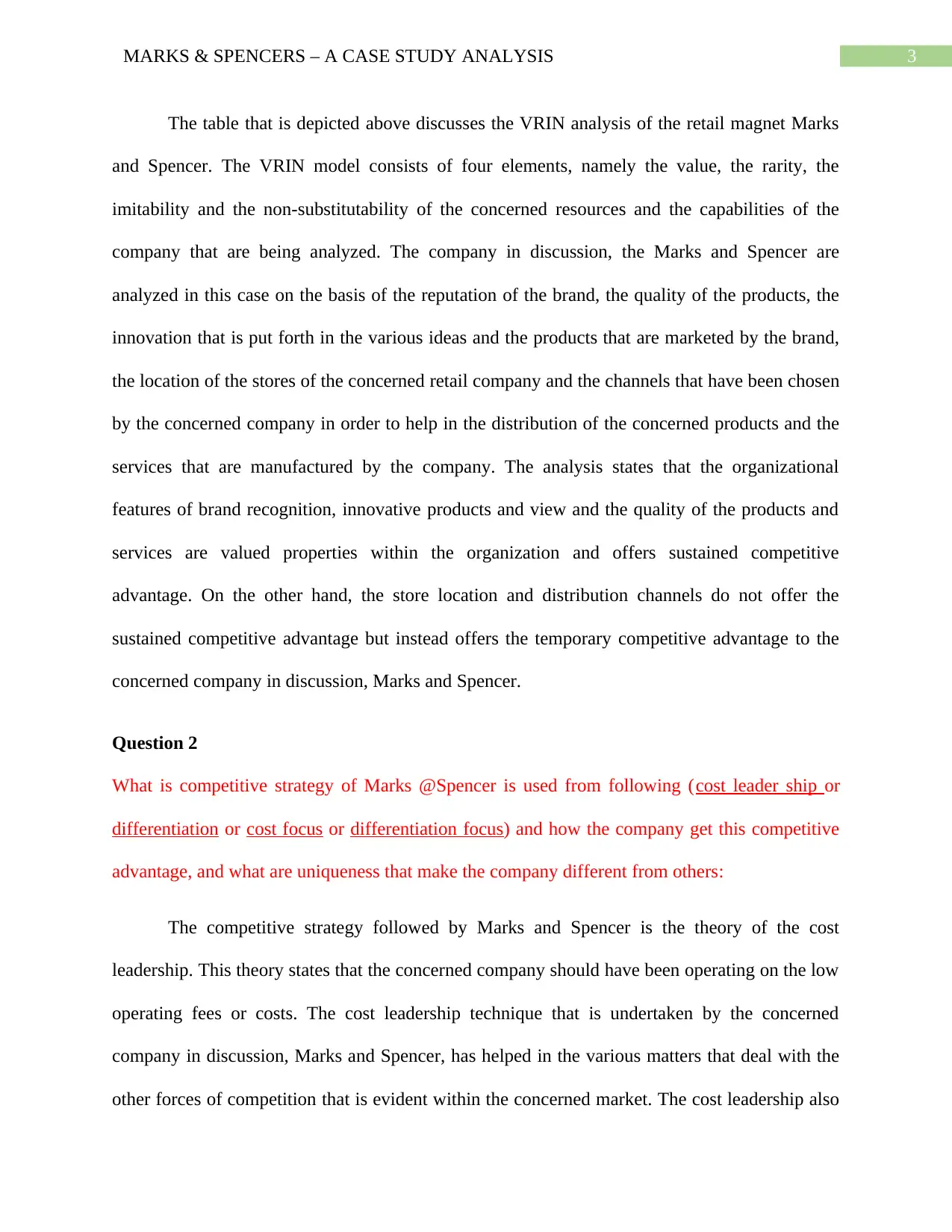
3MARKS & SPENCERS – A CASE STUDY ANALYSIS
The table that is depicted above discusses the VRIN analysis of the retail magnet Marks
and Spencer. The VRIN model consists of four elements, namely the value, the rarity, the
imitability and the non-substitutability of the concerned resources and the capabilities of the
company that are being analyzed. The company in discussion, the Marks and Spencer are
analyzed in this case on the basis of the reputation of the brand, the quality of the products, the
innovation that is put forth in the various ideas and the products that are marketed by the brand,
the location of the stores of the concerned retail company and the channels that have been chosen
by the concerned company in order to help in the distribution of the concerned products and the
services that are manufactured by the company. The analysis states that the organizational
features of brand recognition, innovative products and view and the quality of the products and
services are valued properties within the organization and offers sustained competitive
advantage. On the other hand, the store location and distribution channels do not offer the
sustained competitive advantage but instead offers the temporary competitive advantage to the
concerned company in discussion, Marks and Spencer.
Question 2
What is competitive strategy of Marks @Spencer is used from following (cost leader ship or
differentiation or cost focus or differentiation focus) and how the company get this competitive
advantage, and what are uniqueness that make the company different from others:
The competitive strategy followed by Marks and Spencer is the theory of the cost
leadership. This theory states that the concerned company should have been operating on the low
operating fees or costs. The cost leadership technique that is undertaken by the concerned
company in discussion, Marks and Spencer, has helped in the various matters that deal with the
other forces of competition that is evident within the concerned market. The cost leadership also
The table that is depicted above discusses the VRIN analysis of the retail magnet Marks
and Spencer. The VRIN model consists of four elements, namely the value, the rarity, the
imitability and the non-substitutability of the concerned resources and the capabilities of the
company that are being analyzed. The company in discussion, the Marks and Spencer are
analyzed in this case on the basis of the reputation of the brand, the quality of the products, the
innovation that is put forth in the various ideas and the products that are marketed by the brand,
the location of the stores of the concerned retail company and the channels that have been chosen
by the concerned company in order to help in the distribution of the concerned products and the
services that are manufactured by the company. The analysis states that the organizational
features of brand recognition, innovative products and view and the quality of the products and
services are valued properties within the organization and offers sustained competitive
advantage. On the other hand, the store location and distribution channels do not offer the
sustained competitive advantage but instead offers the temporary competitive advantage to the
concerned company in discussion, Marks and Spencer.
Question 2
What is competitive strategy of Marks @Spencer is used from following (cost leader ship or
differentiation or cost focus or differentiation focus) and how the company get this competitive
advantage, and what are uniqueness that make the company different from others:
The competitive strategy followed by Marks and Spencer is the theory of the cost
leadership. This theory states that the concerned company should have been operating on the low
operating fees or costs. The cost leadership technique that is undertaken by the concerned
company in discussion, Marks and Spencer, has helped in the various matters that deal with the
other forces of competition that is evident within the concerned market. The cost leadership also
Paraphrase This Document
Need a fresh take? Get an instant paraphrase of this document with our AI Paraphraser
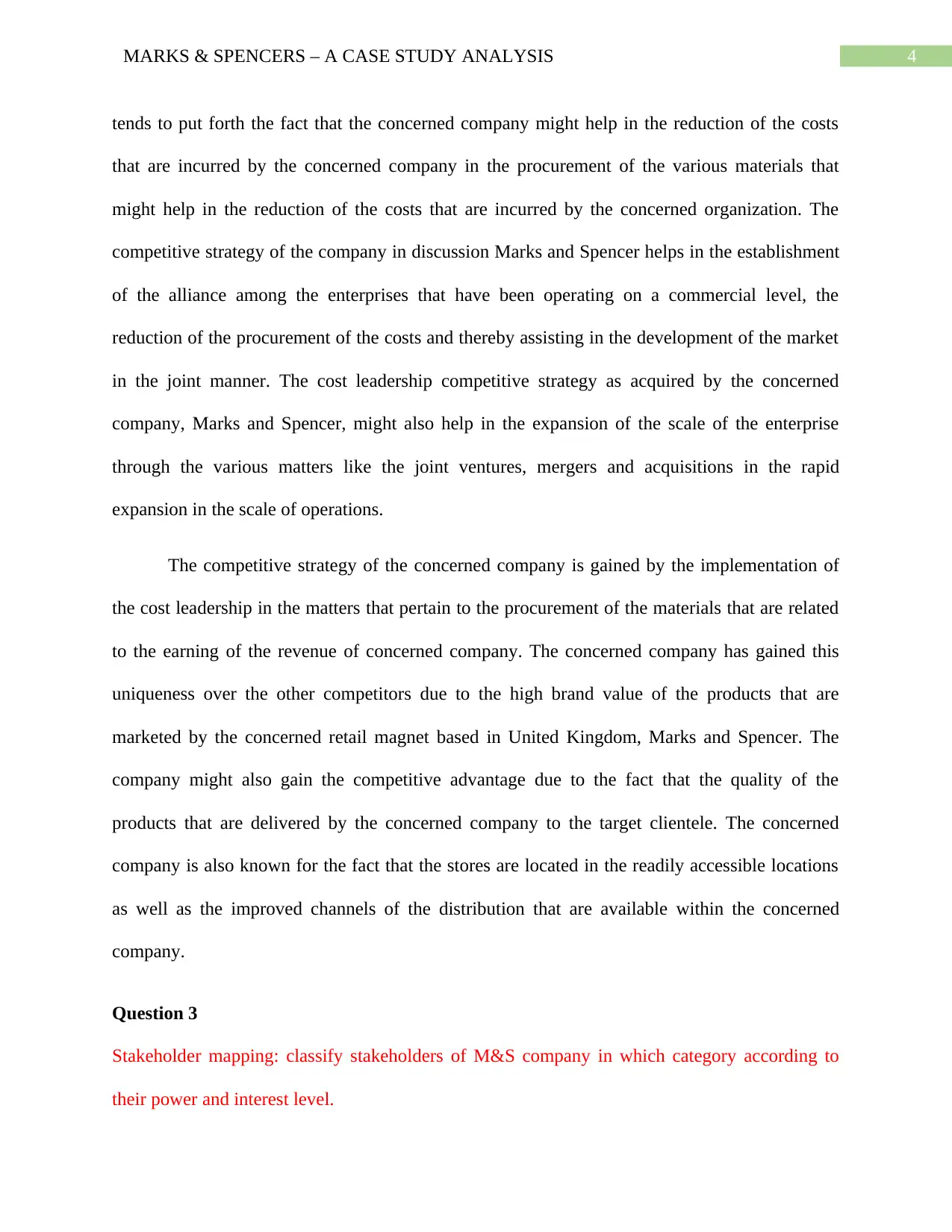
4MARKS & SPENCERS – A CASE STUDY ANALYSIS
tends to put forth the fact that the concerned company might help in the reduction of the costs
that are incurred by the concerned company in the procurement of the various materials that
might help in the reduction of the costs that are incurred by the concerned organization. The
competitive strategy of the company in discussion Marks and Spencer helps in the establishment
of the alliance among the enterprises that have been operating on a commercial level, the
reduction of the procurement of the costs and thereby assisting in the development of the market
in the joint manner. The cost leadership competitive strategy as acquired by the concerned
company, Marks and Spencer, might also help in the expansion of the scale of the enterprise
through the various matters like the joint ventures, mergers and acquisitions in the rapid
expansion in the scale of operations.
The competitive strategy of the concerned company is gained by the implementation of
the cost leadership in the matters that pertain to the procurement of the materials that are related
to the earning of the revenue of concerned company. The concerned company has gained this
uniqueness over the other competitors due to the high brand value of the products that are
marketed by the concerned retail magnet based in United Kingdom, Marks and Spencer. The
company might also gain the competitive advantage due to the fact that the quality of the
products that are delivered by the concerned company to the target clientele. The concerned
company is also known for the fact that the stores are located in the readily accessible locations
as well as the improved channels of the distribution that are available within the concerned
company.
Question 3
Stakeholder mapping: classify stakeholders of M&S company in which category according to
their power and interest level.
tends to put forth the fact that the concerned company might help in the reduction of the costs
that are incurred by the concerned company in the procurement of the various materials that
might help in the reduction of the costs that are incurred by the concerned organization. The
competitive strategy of the company in discussion Marks and Spencer helps in the establishment
of the alliance among the enterprises that have been operating on a commercial level, the
reduction of the procurement of the costs and thereby assisting in the development of the market
in the joint manner. The cost leadership competitive strategy as acquired by the concerned
company, Marks and Spencer, might also help in the expansion of the scale of the enterprise
through the various matters like the joint ventures, mergers and acquisitions in the rapid
expansion in the scale of operations.
The competitive strategy of the concerned company is gained by the implementation of
the cost leadership in the matters that pertain to the procurement of the materials that are related
to the earning of the revenue of concerned company. The concerned company has gained this
uniqueness over the other competitors due to the high brand value of the products that are
marketed by the concerned retail magnet based in United Kingdom, Marks and Spencer. The
company might also gain the competitive advantage due to the fact that the quality of the
products that are delivered by the concerned company to the target clientele. The concerned
company is also known for the fact that the stores are located in the readily accessible locations
as well as the improved channels of the distribution that are available within the concerned
company.
Question 3
Stakeholder mapping: classify stakeholders of M&S company in which category according to
their power and interest level.
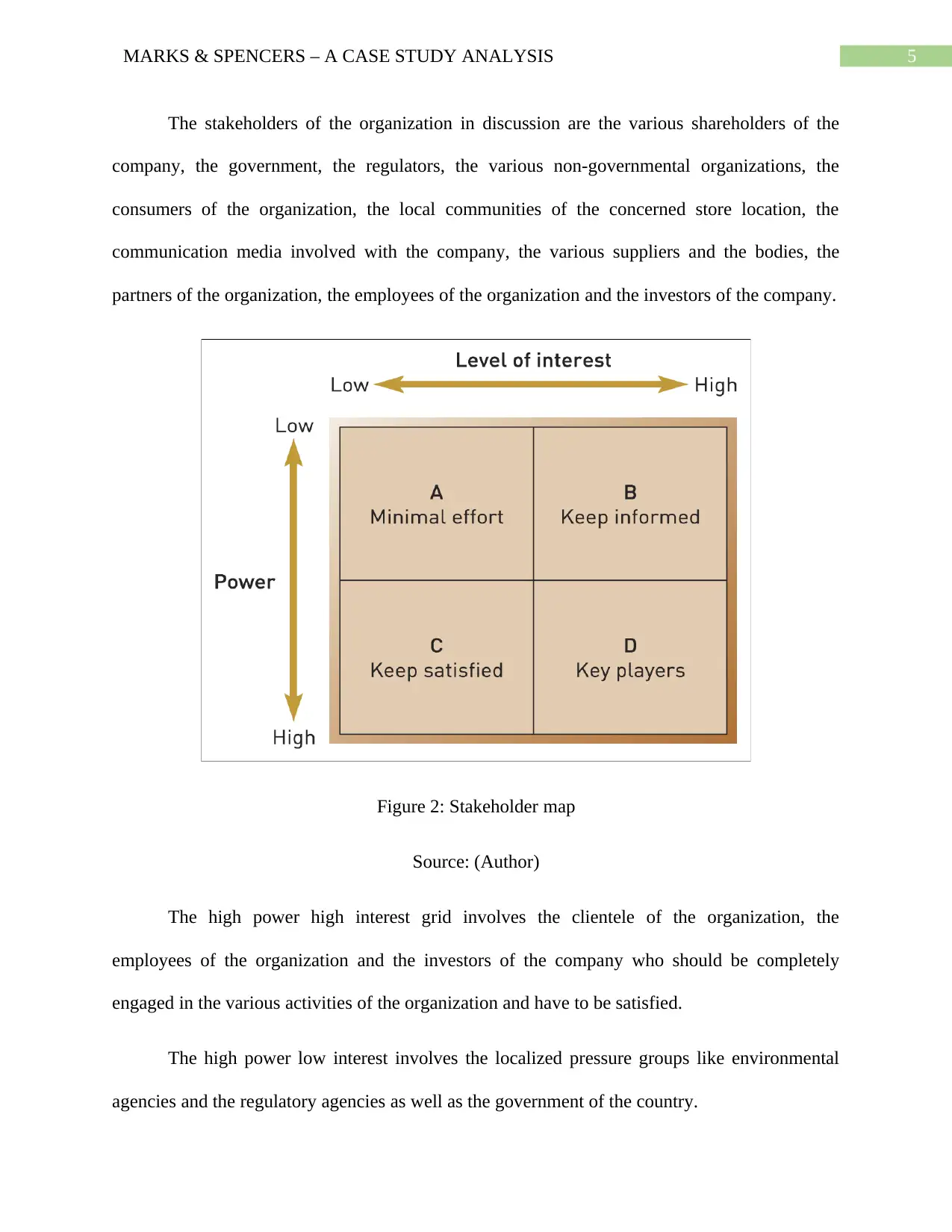
5MARKS & SPENCERS – A CASE STUDY ANALYSIS
The stakeholders of the organization in discussion are the various shareholders of the
company, the government, the regulators, the various non-governmental organizations, the
consumers of the organization, the local communities of the concerned store location, the
communication media involved with the company, the various suppliers and the bodies, the
partners of the organization, the employees of the organization and the investors of the company.
Figure 2: Stakeholder map
Source: (Author)
The high power high interest grid involves the clientele of the organization, the
employees of the organization and the investors of the company who should be completely
engaged in the various activities of the organization and have to be satisfied.
The high power low interest involves the localized pressure groups like environmental
agencies and the regulatory agencies as well as the government of the country.
The stakeholders of the organization in discussion are the various shareholders of the
company, the government, the regulators, the various non-governmental organizations, the
consumers of the organization, the local communities of the concerned store location, the
communication media involved with the company, the various suppliers and the bodies, the
partners of the organization, the employees of the organization and the investors of the company.
Figure 2: Stakeholder map
Source: (Author)
The high power high interest grid involves the clientele of the organization, the
employees of the organization and the investors of the company who should be completely
engaged in the various activities of the organization and have to be satisfied.
The high power low interest involves the localized pressure groups like environmental
agencies and the regulatory agencies as well as the government of the country.
⊘ This is a preview!⊘
Do you want full access?
Subscribe today to unlock all pages.

Trusted by 1+ million students worldwide
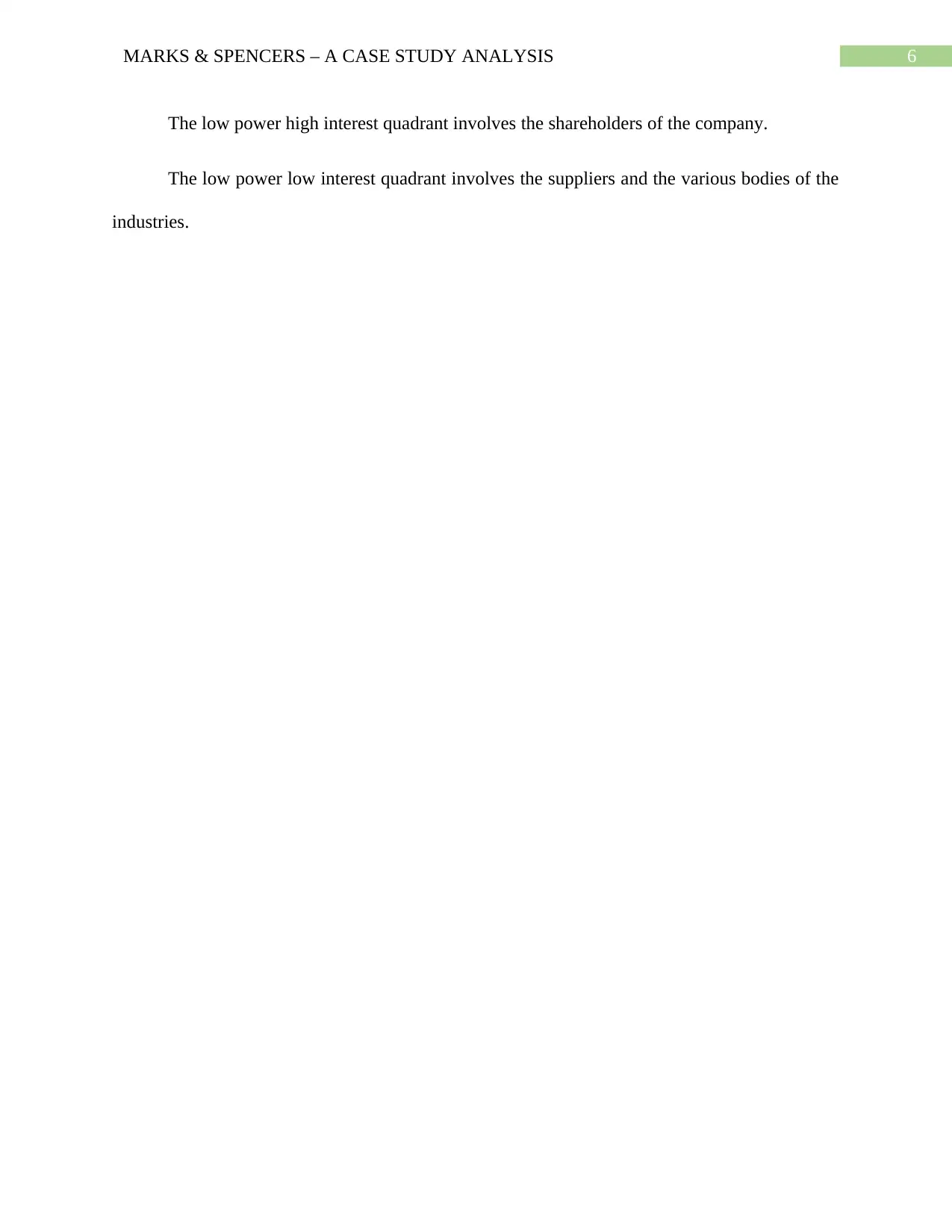
6MARKS & SPENCERS – A CASE STUDY ANALYSIS
The low power high interest quadrant involves the shareholders of the company.
The low power low interest quadrant involves the suppliers and the various bodies of the
industries.
The low power high interest quadrant involves the shareholders of the company.
The low power low interest quadrant involves the suppliers and the various bodies of the
industries.
1 out of 7
Related Documents
Your All-in-One AI-Powered Toolkit for Academic Success.
+13062052269
info@desklib.com
Available 24*7 on WhatsApp / Email
![[object Object]](/_next/static/media/star-bottom.7253800d.svg)
Unlock your academic potential
Copyright © 2020–2025 A2Z Services. All Rights Reserved. Developed and managed by ZUCOL.





